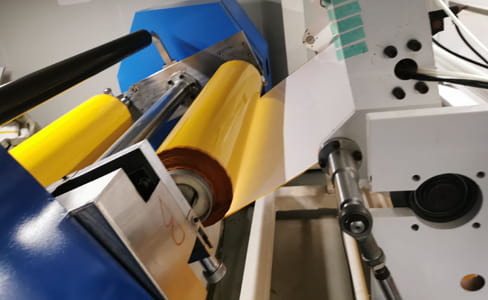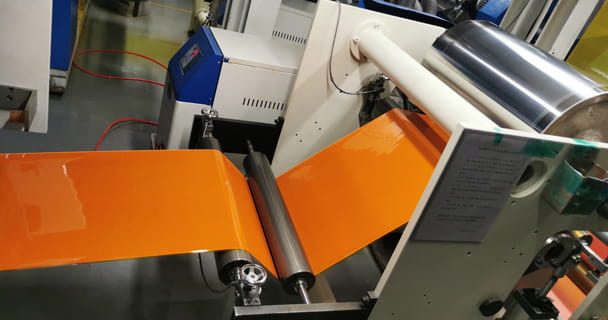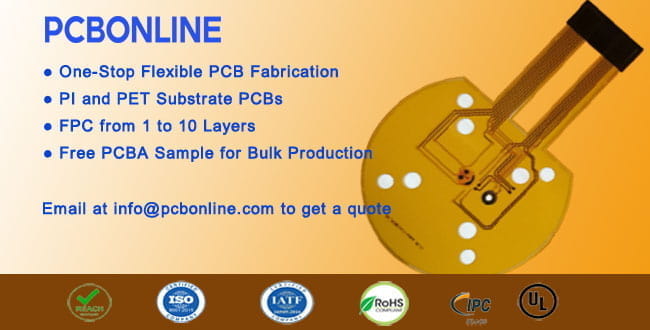The protective coating film of rigid printed circuit boards is a solder mask, and that of flexible PCBs is coverlay. This article will give a full introduction to the coverlay of flexible PCBs, including its materials, colors, thicknesses, and frequently asked questions about flexible PCB coverlay.
Part 1: What is Flexible PCB Coverlay
Coverlay is the protective film of flexible PCBs, which plays the same functions as the solder mask of rigid PCBs:
- Insulate the copper foil (RA copper or ED copper) from the air and protect it from oxidation
- Cover the bare areas and circuit traces and protect them from soldering
- Prepare for surface finishes to PCB pads
Coverlay is insulating resin, and typical coverlay materials are polyimide (PI) and transparent polyester (PET). It has excellent dielectric properties and abrasion resistance, and flex PCBs can be used in aerospace, defense, medical, and precise electronics fields.

Coverlay includes a PI or PET film and an adhesive layer. The adhesive is brushed on the PI or PET film and then laminated under high temperatures and pressures, and a flexible PCB coverlay is formed.
Flexible PCB PI film coverlay can have the color yellow, white, or black. PET film coverlay is transparent.
During flexible PCB manufacturing, the coverlay is laminated with copper foil first, and then the other side of the copper is etched to generate circuit traces.

Part 2: Flexible PCB Coverlay Thicknesses
The thicknesses of PI/PET, adhesive, and copper decide the thickness of the flexible PCB. What thicknesses of them are available from the flexible PCB supplier?
![]()
PCBONLINE, a one-stop flexible PCB manufacturer, not only fabricates flexible PCBs but also produces flexible PCB laminates and coverlay. Please check the below thicknesses of flexible PCB coverlay and copper from PCBONLINE.
Available PI thicknesses:
- 12.5μm,
- 25μm,
- 50μm,
- 75μm
Available adhesive thicknesses:
20μm
Available RA/ED copper thicknesses:
- 12μm,
- 18μm,
- 35μm (1oz),
- 70μm (2oz),
The minimum flexible PCB thickness from PCBONLINE is 2.36mm. Besides, you can have transparent PET flexible PCBs manufactured by PCBONLINE.

By ordering flexible PCBs from PCBONLINE, you can enjoy these benefits:
- One-stop flexible PCB fabrication and assembly from prototype to bulk production
- One-on-one engineering support and design assistance throughout your project
- Strong manufacturing capabilities - FPC from 1 to 10 layers, single-sided, double-sided
- If you need flexible PCB design, our CAM engineer with more than 20 years of experience can also help
- Free complete FPC sample and functional jig testing for bulk production
If you have inquiries about flexible PCBs/PCBA, coverlay, or laminates, please feel free to email PCBONLINE at info@pcbonline.com to get a quote.
Part 3: Flexible PCB Coverlay vs PCB Solder Mask
Though coverlay and solder mask both insulate and protect the circuit, they are made of different materials and have different characteristics.
- PI and PET coverlay is made of insulating resin, which is non-photosensitive. While the PCB solder mask is made of UV-photosensitive ink.
- Flexible PCB coverlay can be bent without harm, while PCB solder mask has poor flexibility.
- The color of the PCB solder mask can be green, black, white, red, blue, yellow, pink, purple, etc. While the typical color of flexible PCB coverlay is yellow, black, or white.
Frequently Asked Questions about Coverlay of Flexible PCBs
Question 1. In flexible PCB fabrication, is the opening on the PI film coverlay in the same shape and size as the design, or should I change the design according to your fabrication capability?
If you have FPCs manufactured from PCBONLINE, you don't have to change your design.
Usually, in the PCB design, the opening shape is square or rectangular. But most fabricators will require you to change it to be oval because their factories adopt the mechanical drilling method.
PCBONLINE provides two drilling options: mechanical drilling and punching. By punching, the opening on the coverlay is square or rectangular and the same as your design.
![]()
Question 2. What's the difference between PI film coverlay and PI stiffeners?
Coverlay is similar to the solder mask and protects the copper circuits, while a stiffener is a strengthened area at the ends of the flexible PCBs used for the plug-in. Besides PI, flexible PCB stiffeners can also be stainless steel and FR4. Coverlay is necessary for flexible PCBs and the flex section of rigid-flex PCBs, while stiffeners are used only when there are plug-in needs, such as gold fingers.
Conclusion
Coverlay is a PI or PET film laminated with the adhesive used for insulating and protecting the circuits in flexible PCBs. This article gives a comprehensive introduction to flexible PCB coverlay. If you work with the one-stop FPC manufacturer PCBONLINE, the CAM engineering level, fabrication quality, and one-on-one services won't let you down.
© This article is an original work of the PCBONLINE team. Please indicate the author PCBONLINE if you reprint. If the article is reproduced without permission or indicating the author's source, PCBONLINE reserves the right to investigate the infringement.




